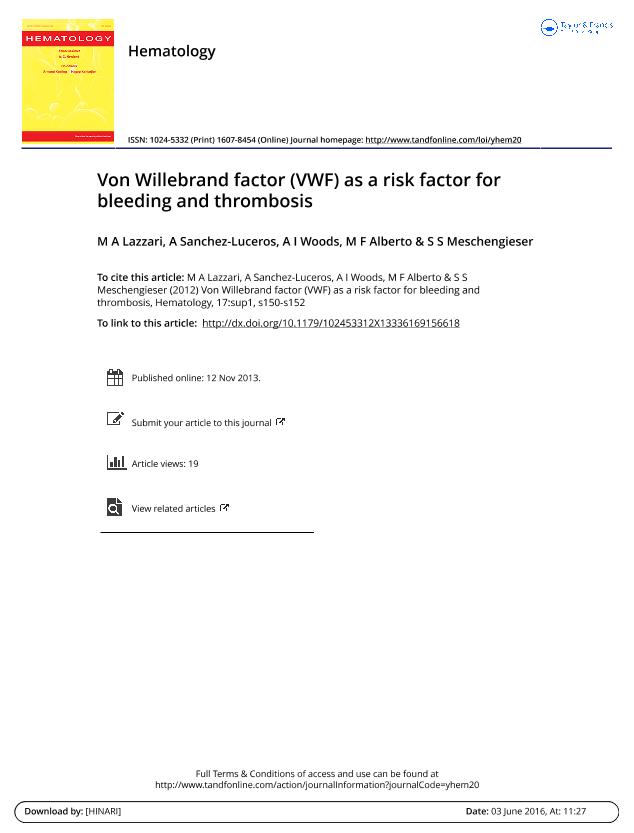Artículo
Von Willebrand factor (VWF) as a risk factor for bleeding and thrombosis
Lazzari, María Ángela ; Sánchez Luceros, Analía Gabriela
; Sánchez Luceros, Analía Gabriela ; Woods, Adriana Inés
; Woods, Adriana Inés ; Alberto, Maria Fabiana; Meschengieser, Carolina
; Alberto, Maria Fabiana; Meschengieser, Carolina
 ; Sánchez Luceros, Analía Gabriela
; Sánchez Luceros, Analía Gabriela ; Woods, Adriana Inés
; Woods, Adriana Inés ; Alberto, Maria Fabiana; Meschengieser, Carolina
; Alberto, Maria Fabiana; Meschengieser, Carolina
Fecha de publicación:
04/2012
Editorial:
Maney Publishing
Revista:
Hematology
ISSN:
1024-5332
Idioma:
Inglés
Tipo de recurso:
Artículo publicado
Clasificación temática:
Resumen
The von Willebrand factor (VWF) is analysed as a bleeding and thrombotic risk marker. When the VWF level is increased, it predicts a thrombotic phenotype and when VWF level is low in plasma, the phenotype varies to bleeding disorder. But it is quite challenging to define when the level is low, normal or high taking into account that these values are capricious and overlap. This matter should be solved by extensive epidemiologic studies. VWD is a hereditary disorder with several described mutations. VWF is a major acute-phase reactant, besides the physiological conditions such as blood group and pregnancy that affect plasmatic VWF levels. Subjects with O blood group have 25% less VWF than those of non O blood groups, and the latter show higher thrombus burden. VWF would be sensitive though not specific diagnostic marker of myocardial infarction. For the assessment of bleeding severity there are special surveys, scores and pictorial charts. The identification of VWF as a thrombotic risk marker has not been clearly established yet, but it has been involved in stroke and coronary disease. We only have the specific replacement therapy for the bleeding phenotype and we can speculate that enoxaparin and PEG-hirudin are able to blunt the VWF rise in patients with unstable angina pectoris and it is associated with a more favourable clinical outcome. Only two questions remain: does VWF as a bleeding risk marker have the same value as a thrombotic risk marker? Will successful treatments like those achieved for bleeding be also possible in the future for thrombosis?.
Palabras clave:
BLEEDING PHENOTYPE
,
PHYSIOLOGICAL VARIATIONS
,
RISK MARKER
,
THROMBOSIS
,
VWF
Archivos asociados
Licencia
Identificadores
Colecciones
Articulos(IMEX)
Articulos de INST.DE MEDICINA EXPERIMENTAL
Articulos de INST.DE MEDICINA EXPERIMENTAL
Citación
Lazzari, María Ángela; Sánchez Luceros, Analía Gabriela; Woods, Adriana Inés; Alberto, Maria Fabiana; Meschengieser, Carolina; Von Willebrand factor (VWF) as a risk factor for bleeding and thrombosis; Maney Publishing; Hematology; 17; SUPPL. 1; 4-2012; 150-152
Compartir
Altmétricas



